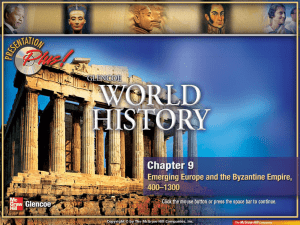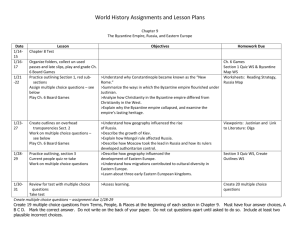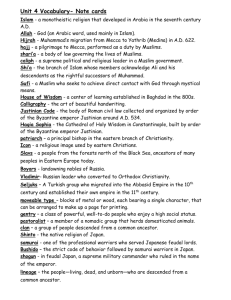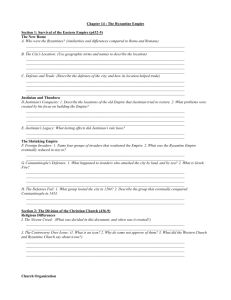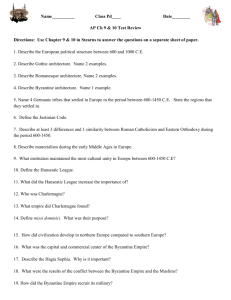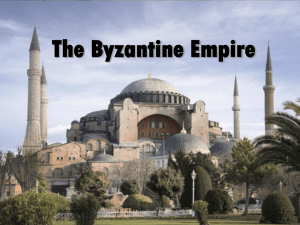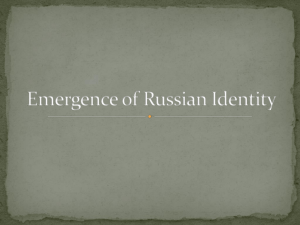Emerging Europe & Byzantine Empire Worksheet (400-1300)
advertisement
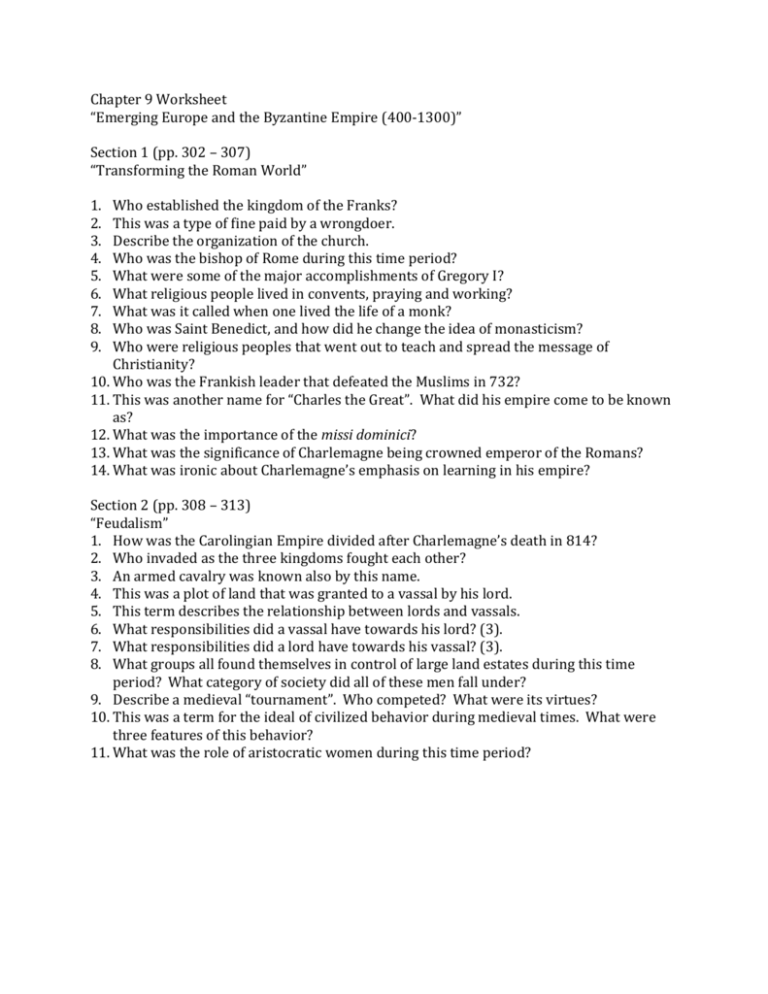
Chapter 9 Worksheet “Emerging Europe and the Byzantine Empire (400-1300)” Section 1 (pp. 302 – 307) “Transforming the Roman World” 1. 2. 3. 4. 5. 6. 7. 8. 9. Who established the kingdom of the Franks? This was a type of fine paid by a wrongdoer. Describe the organization of the church. Who was the bishop of Rome during this time period? What were some of the major accomplishments of Gregory I? What religious people lived in convents, praying and working? What was it called when one lived the life of a monk? Who was Saint Benedict, and how did he change the idea of monasticism? Who were religious peoples that went out to teach and spread the message of Christianity? 10. Who was the Frankish leader that defeated the Muslims in 732? 11. This was another name for “Charles the Great”. What did his empire come to be known as? 12. What was the importance of the missi dominici? 13. What was the significance of Charlemagne being crowned emperor of the Romans? 14. What was ironic about Charlemagne’s emphasis on learning in his empire? Section 2 (pp. 308 – 313) “Feudalism” 1. How was the Carolingian Empire divided after Charlemagne’s death in 814? 2. Who invaded as the three kingdoms fought each other? 3. An armed cavalry was known also by this name. 4. This was a plot of land that was granted to a vassal by his lord. 5. This term describes the relationship between lords and vassals. 6. What responsibilities did a vassal have towards his lord? (3). 7. What responsibilities did a lord have towards his vassal? (3). 8. What groups all found themselves in control of large land estates during this time period? What category of society did all of these men fall under? 9. Describe a medieval “tournament”. Who competed? What were its virtues? 10. This was a term for the ideal of civilized behavior during medieval times. What were three features of this behavior? 11. What was the role of aristocratic women during this time period? Section 3 (pp. 316 – 321) “The Growth of European Kingdoms” 1. Who won the Battle of Hastings? Who was the leader of this group? 2. What was the name of the survey issued by William I that was taken across England? 3. Which royal in England expanded the power of the courts in England? 4. This policy was the replacement for rule by local codes. 5. Who was Thomas a Becket? Why was he murdered, and by whom? 6. What was the Magna Carta? How did the document pave the way for citizens’ rights? 7. Otto I was granted this privilege in exchange for protecting the pope. 8. Who were the Slavs? 9. Eastern Slavic people were converted to Christianity by whom? 10. Native people in Russia and Ukraine were conquered by which group(s)? 11. Descendants of this man became princes of Moscow. 12. *Orthodox Christianity became the chief religion for which nations? Who rejected the movement? Section 4 (pp. 322 – 327) “Byzantine Empire and Crusades” 1. What was Justinian’s goal when he came to power in the Eastern Roman Empire in 527? 2. What were some of the weaknesses of the Eastern Roman Empire under Justinian? 3. This was the official name of the Eastern Roman Empire by the eighth century. 4. Who was the head of the Eastern Orthodox Church? 5. Until the 12th century, Constantinople was one of Europe’s most powerful and significant cities for what reasons? (3) 6. *List some of Justinian’s major accomplishments. (3) 7. The Macedonian emperors expanded the Byzantine Empire to these regions. (4) 8. This was the official name for the religious separation that occurred during this time period. What was the main disagreement between East and West? 9. Byzantine emperor Alexius I asked Europeans for help against this group. 10. These were violent expeditions by Christians made with the intent of regaining the Holy Land. Who were they fighting? 11. This was another name for “non-believers”. 12. In 1204, crusading armies sacked what major European city?

